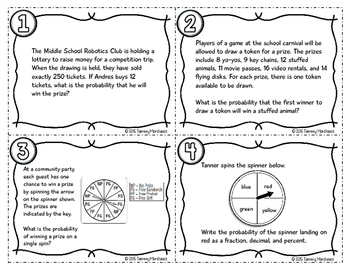Probability, Simple & Compound Task Cards
The Morehouse Magic
11.2k Followers
Grade Levels
5th - 9th, Homeschool
Subjects
Resource Type
Standards
CCSS7.SP.C.5
CCSS7.SP.C.6
CCSS7.SP.C.7
CCSS7.SP.C.7a
CCSS7.SP.C.7b
Formats Included
- PDF
Pages
14 pages
The Morehouse Magic
11.2k Followers
What educators are saying
I used these resources as a review station on probability. I loved that the task cards had a variety of difficulties. This allowed all students to participate.
My students enjoyed using this as extra practice and the extra practice was fun. I will use it again next year when teaching this standard.
Description
Probability, Simple & Compound Task Cards
This is a set of 24 task cards covering multiple representations of simple and compound probability. The questions are differentiated for a wide range of learners. These cards would be great for bell ringers, math stations, test prep, review, or just for fun!
What you get:
➸ 24 color task cards
➸ 24 black and white task cards
➸ Student answer sheet
➸ Key
You can laminate these and use them again and again. You could also hole punch each and keep them on a key ring for quick reference.
You may also like my other math task cards:
Data Analysis Task Cards
Interpreting Graphs Task Cards
Parallel Lines & Transversals Task Cards
▩▩▩▩▩▩▩▩▩▩▩▩▩▩▩▩▩▩▩▩▩▩▩▩▩▩▩▩▩▩▩▩▩▩▩▩▩▩▩▩▩▩▩▩▩▩▩▩▩▩▩▩▩▩▩▩▩▩▩▩
How to earn TPT credits to use on future purchases:
▩ Please go to your My Purchases page. Beside each purchase you'll see a Provide Feedback button. Simply click it and you will be taken to a page where you can give a quick rating and leave a short comment for the product. You can check your credit balance in your TpT Credit Balance page. Every 100 Credits is worth $5 that you can apply towards future TpT purchases in my store, or any TpT store.
Be the first to know about my new products, discounts, and freebies:
▩ Look for the green star next to my store logo and click it to become a follower. You’ll receive customized email updates about this store, and be the first to know when new products are added.
Connect with me
Visit The Morehouse Magic Blog
The Morehouse Magic on Facebook
The Morehouse Magic on Pinterest
The Morehouse Magic on Instagram
This is a set of 24 task cards covering multiple representations of simple and compound probability. The questions are differentiated for a wide range of learners. These cards would be great for bell ringers, math stations, test prep, review, or just for fun!
What you get:
➸ 24 color task cards
➸ 24 black and white task cards
➸ Student answer sheet
➸ Key
You can laminate these and use them again and again. You could also hole punch each and keep them on a key ring for quick reference.
You may also like my other math task cards:
Data Analysis Task Cards
Interpreting Graphs Task Cards
Parallel Lines & Transversals Task Cards
▩▩▩▩▩▩▩▩▩▩▩▩▩▩▩▩▩▩▩▩▩▩▩▩▩▩▩▩▩▩▩▩▩▩▩▩▩▩▩▩▩▩▩▩▩▩▩▩▩▩▩▩▩▩▩▩▩▩▩▩
How to earn TPT credits to use on future purchases:
▩ Please go to your My Purchases page. Beside each purchase you'll see a Provide Feedback button. Simply click it and you will be taken to a page where you can give a quick rating and leave a short comment for the product. You can check your credit balance in your TpT Credit Balance page. Every 100 Credits is worth $5 that you can apply towards future TpT purchases in my store, or any TpT store.
Be the first to know about my new products, discounts, and freebies:
▩ Look for the green star next to my store logo and click it to become a follower. You’ll receive customized email updates about this store, and be the first to know when new products are added.
Connect with me
Visit The Morehouse Magic Blog
The Morehouse Magic on Facebook
The Morehouse Magic on Pinterest
The Morehouse Magic on Instagram
Total Pages
14 pages
Answer Key
Included
Teaching Duration
N/A
Report this resource to TPT
Reported resources will be reviewed by our team. Report this resource to let us know if this resource violates TPT’s content guidelines.
Standards
to see state-specific standards (only available in the US).
CCSS7.SP.C.5
Understand that the probability of a chance event is a number between 0 and 1 that expresses the likelihood of the event occurring. Larger numbers indicate greater likelihood. A probability near 0 indicates an unlikely event, a probability around 1/2 indicates an event that is neither unlikely nor likely, and a probability near 1 indicates a likely event.
CCSS7.SP.C.6
Approximate the probability of a chance event by collecting data on the chance process that produces it and observing its long-run relative frequency, and predict the approximate relative frequency given the probability. For example, when rolling a number cube 600 times, predict that a 3 or 6 would be rolled roughly 200 times, but probably not exactly 200 times.
CCSS7.SP.C.7
Develop a probability model and use it to find probabilities of events. Compare probabilities from a model to observed frequencies; if the agreement is not good, explain possible sources of the discrepancy.
CCSS7.SP.C.7a
Develop a uniform probability model by assigning equal probability to all outcomes, and use the model to determine probabilities of events. For example, if a student is selected at random from a class, find the probability that Jane will be selected and the probability that a girl will be selected.
CCSS7.SP.C.7b
Develop a probability model (which may not be uniform) by observing frequencies in data generated from a chance process. For example, find the approximate probability that a spinning penny will land heads up or that a tossed paper cup will land open-end down. Do the outcomes for the spinning penny appear to be equally likely based on the observed frequencies?





